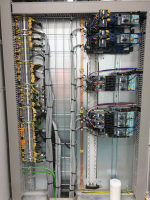Let me first start out with this
A standard I have set for myself for new panels is this,
As I have said this is just a standard I use for myself, I find it works very well and makes things simple for even an inexperienced electrician get the connections right and later it makes it much easier to trouble shoot.
As I am always trying to improve my work I would welcome any and all suggestions you may have to offer to that end.
Everything entering or leaving a panel, where practical is terminated on a terminal block in close proximity to where the wire enters the panel. The exception there would be a power feed over 100 amps would go directly to the disconnect or very large drives then they should be mounted in a way that allows the field installer to access the terminals without accessing the wires in the panel.
Never ever allow the field installer to access anything beyond the above mentioned terminal blocks, there is just no end to the problems that can create.
Group my terminals together
Power in as a group, motor leads exiting the panel as a group with sub groups per motor with a ground terminal per motor group. Control power out as a group Low voltage power out as a group, sensors / switches in as a group, encoders as a group again with sub groups for each encoder. And then a group for any safety devices external to the panel with a sub groups for monitored and unmonitored circuits each major group separate with a minimum of 2 unused terminals
In addition to the above grouping I also like to use different colors for different type of circuits. Power can be black or standard gray, 120V and above sensors / switches gray, 24 v power and sensors are blue the monitored safety circuits are red unmonitored safety circuits are blue
Leave plenty of extra room for the field wiring to enter the and be terminated.
Another standard is specifying that no holes may be punched in the top of any panel unless a properly installed weather hub is used. I have seen too many times where leak in a pipe or condensation or liquids drip into a panel and cause many problems let’s try and stop the problems before the happen.
I have even taken the extra step and have a local metal show fabricate angled mounting brackets for the DIN rail on the external terminals.
As a note if you are using the DIN rail as a grounding connection ( grounding terminal blocks) you may not use aluminum rail and you must bond it to the panel and the panel ground connection using a separate indentified grounding screw ( Not a mounting screw). Aluminum din rail is not rated for grounding, I think it has to do with aluminum to steel connection is a very poor electrical connection.
One final thing I see that some are concerned that using a terminal block will not have a higher than 10K current interrupt rating. That’s strange because that rating is the maximum fault current interruption rating for the fuse or breaker protecting the panel or device a terminal is not an interrupting device no more than a buss bar or wire is so I would not see how that would have any effect on that rating.





